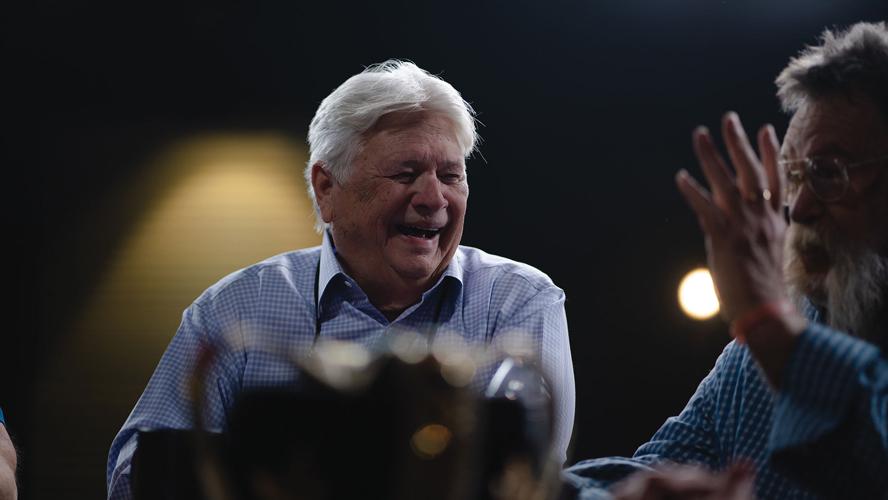
Professional wrestling is an often unfriendly business, and few who succeed in it do so without making enemies. After Jerry Jarrett’s passing on Valentine’s Day this year, countless stories shared about the legendary Tennessee wrestling promoter suggested a different breed: not just a perceptive businessman, but a restless visionary and generous spirit, who cared as much about developing new talent and new ideas as he did maintaining the bottom line.
“I think my dad was a great observer and learner,” remembers Jerry’s son and fellow wrestling legend Jeff Jarrett in conversation with the Scene. “He was self-taught, and it was part of his nature to learn from others and continue to pass that knowledge on.”
Jerry Jarrett was a proud native of Nashville’s 22nd Avenue and would eventually reside in Hendersonville, but his name is synonymous with Memphis, where he founded and operated the Continental Wrestling Association in 1977. Though his most significant accomplishments were behind the scenes, Jarrett was a skilled in-ring competitor as well, claiming several tag-team titles alongside his former teacher Tojo Yamamoto, a Hawaii-born wrestler who played a Japanese heel onscreen and trained countless Memphis alumni offscreen. Those included the younger Jeff, who would become internationally known for his time in the WWF and WCW during the wrestling boom of the 1990s, and today works for All Elite Wrestling.
In its early days, televised wrestling mostly served a promotional function, with filler matches and interview segments aimed at enticing viewers to buy a ticket to the next live show in town — the true main events were reserved for a paying audience. While Jerry Jarrett was hardly the first to tell compelling stories in wrestling through episodic television, his work in the Memphis territory took narrative wrestling to the next level, transforming a style of programming that was essentially glorified commercials into appointment viewing.

The in-ring work was solid quality, but it was the mic work that truly lit Memphis on fire, and the talking would become as much of an attraction as the wrestling itself. Legends like Jerry “The King” Lawler, “Superstar” Bill Dundee and Jimmy Valiant turned “cutting a promo” into an art form all its own. Meanwhile, the iconic archetype of the “heel manager” — villainous agents who interfere in matches and rile up the crowd on behalf of their client — was perfected by talent like Jimmy Hart and Jim Cornette. Almost every wrestling promoter in the United States had to pay television stations out of their own pocket for airtime, but Jarrett’s product was such an enduring ratings success, and his talent roster so beloved, that local station WMC-TV paid him to broadcast the show.
“My father liked to tell stories with emotions, and he was a very innovative mind,” says Jeff. “He was the first to do so many different stipulation matches, like the scaffold match. We did hardcore wrestling years before anyone called it that. We did intergender wrestling in Tennessee in the late 1980s, something that had never been done before.”
The model of weekly TV you see today on shows like Monday Night Raw and AEW Dynamite came from, perhaps more than any other one source, Jerry Jarrett and the style he helped pioneer: the unpredictable feuds and the soap opera melodramatics, the gripping interviews and hard-hitting brawls, the dramatic swerves and over-the-top characters. Countless developments in wrestling that are usually credited to the WWE and Vince McMahon can be traced back to Memphis and the mind of Jerry Jarrett. The first WrestleMania in 1985 became a phenomenon in part because of how the then-WWF embraced pop music and celebrity culture. But before Hulk Hogan ever amped up the crowd to “Eye of the Tiger” or walked to the ring with Mr. T, CWA was using music by ZZ Top and Lynyrd Skynyrd and bringing in Andy Kaufman to feud with Jerry Lawler. Hulk Hogan’s name was even Jerry’s idea: He nicknamed a young Terry Bollea “The Hulk” after an appearance in Memphis alongside Lou Ferrigno — the future Hulkster standing head-and-shoulders above television’s Incredible Hulk.
As McMahon drove his competitors out of business throughout the 1980s and 1990s, Jarrett was the very last of the regional holdouts. Working alongside Jeff, Jerry Jarrett would return to running shows in the area with NWA-TNA, now known as IMPACT Wrestling but still based in Nashville. Though Jerry’s involvement with the company lasted only a few years, the evocatively named Total Nonstop Action Wrestling was like Memphis 2.0, infusing old school Southern grappling and scandalous story lines with a modern extreme-sports flavor. As one of the few mainstream challengers to WWE’s chokehold over American pro wrestling in the 2000s, TNA was the first introduction many fans of a certain age had to wrestling outside the WWE monopoly, and a glimpse of the countless styles that lay beyond it.
Jerry Jarrett’s business acumen and creative enthusiasm extended outside wrestling as well. “He approached everything with a passion, no matter if he was in the wrestling industry or outside of it,” says Jeff. “He had his construction business and car lots, but he would even get really into hobbies like collecting knives or antiques, and he was an avid reader of everything. Whatever he did, he had such a passion for it, and for life in general.”
It’s that singular passion that made Memphis wrestling so distinctive, and it lives on in the explosive drama that grips wrestling fans the world over every week.



